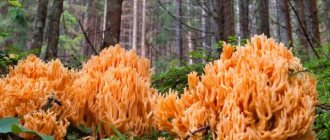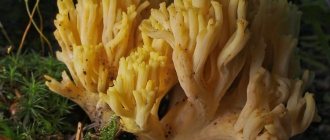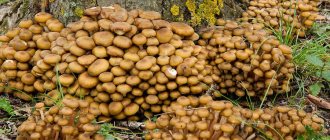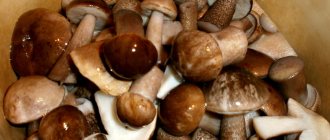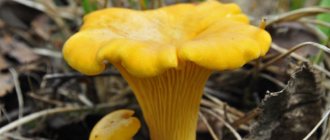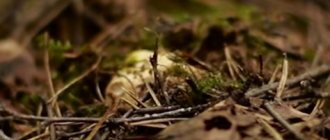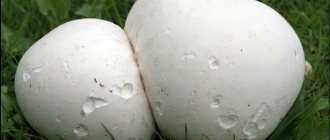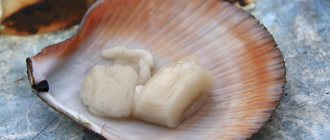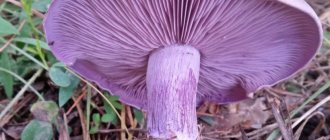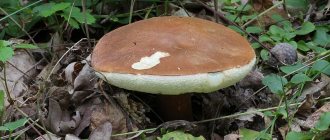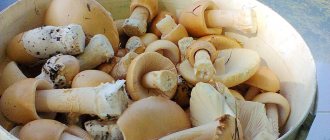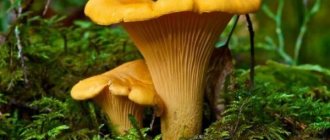The mushroom belongs to the category of edible species, has excellent taste, it can be salted, pickled, fried, etc. Find out how and where you can find amazing fruits in the forest, how to correctly identify them and what delicious things to cook from horned mushrooms.
Where does yellow ramaria grow?
Deer horns are a unique mushroom in appearance, the fruiting body of which has many branches. Its main feature is vertical growth. The Latin name for ramaria is Ramaria flava. Plant class – Agaricomycetes. It grows exclusively on the ground, in coniferous, deciduous and mixed forests. Sometimes witch circles and crooked lines appear where the fungus grows. They are characteristic of specimens growing on coniferous trees. Deer antlers are classified as parasites. They settle on sick trees, gradually turning them into dust.
Yellow horned mushroom is found both in groups and one mushroom at a time. It is represented in greatest numbers in the forests of Karelia, Primorsky Krai and the Caucasus. Recently, deer horn mushrooms have begun to be found in Crimea. Due to the mild climate, Crimean mushrooms and deer horns are collected already at the beginning of summer. Outside of Russia, they are common in Central European countries. Due to its rarity and uniqueness, the deer horn mushroom is listed in the Red Book. Therefore, it is officially prohibited for collection. Despite this, the product is used not only in cooking, but also in alternative medicine. This is facilitated by the abundance of beneficial properties and rich composition.
Treatment options
Every year, hundreds of thousands of mushroom pickers, in search of profit, try to find as many rare and therefore expensive fruits as possible. And unlike mushroom pickers with less experience, experienced representatives of this hobby can tell you for sure that, regardless of their high cost, even the most valuable mushrooms have several poisonous doubles that even the sharpest eye cannot distinguish. This is practically the entire genus Ramaria, due to the similarity of species of which it is quite difficult to find differences between edible and not so species.
And if it so happens that during your hike you did consume a poisonous fruit of this kind, then here are the following instructions for action to avoid most of the adverse consequences:
- At the very first symptoms, do not be afraid to call a doctor, because in the absence of qualifications, drugs taken in haste can only intensify the effect of poisoning of the esophagus.
- Even a weak concentration of poison must be diluted, since for the size of your body you could take a lethal dose. Drinking a large amount of water, which can be diluted with a weak solution of manganese, will help you with this.
- At the first opportunity, use enterosorbents - this group includes preparations such as activated carbon, smecta and etherosgel. They help speed up the removal of toxic substances from your body.
- Try not to be nervous, since Ramaria’s poison is not strong, but increased blood pressure as a result of hysteria can worsen the already unpleasant symptoms of poisoning.
- After the doctors arrive, listen carefully to their instructions. Do not be afraid if you are prescribed a therapeutic enema, because this method of treatment is the most effective for gastrointestinal poisoning.
What does a yellow hornet look like?
It is no coincidence that the name Rotatorik got its name. The mushrooms, photos of which are posted below, resemble deer antlers. The height of the fruiting body can reach 20 cm. The diameter of the mushroom is 15 cm. The fruiting body is connected to the ground by a kind of “stump”. From it there are multiple branches with truncated ends. The color of the mushroom varies from light yellow to deep orange. At the base, the shade of the fruiting body does not change; it is almost always white. The fracture site is dirty white. The mushroom pulp is slightly moist, the smell of the mushrooms is herbaceous.
The pulp of horned mushrooms is often cooked in batter and marinated in sauce
Comment! Mature deer antlers are not eaten because of their pronounced bitterness.
Salad
Mushroom salad of deer legs with fresh cucumber is an unusual appetizer that saturates the body with useful substances.
Ingredients:
- chicken eggs – 2 pcs.;
- bell pepper – 1 fruit;
- deer horns – 300 g;
- fresh cucumber – 1 pc.;
- mayonnaise – 2 tbsp. l.;
- pepper and salt - to taste.
Calorie content
| Calorie content | Squirrels | Fats | Carbohydrates |
| 87.5 kcal | 4.1 g | 5.6 g | 4.1 g |
The dish will be less nutritious if you fill it with sour cream instead of mayonnaise. For a hearty snack, you can add boiled meat to the composition.
Step-by-step instruction:
- Carefully sort the mushrooms, wash them, cut off the ends of the branches and stems. Pour in enough water and boil until tender for 20 minutes, skimming the foam from the surface.
- Drain the deer horns in a colander, cool and divide into medium-sized pieces.
- In a separate bowl, hard boil the eggs, cool in ice water, peel and chop.
- Wash the cucumber under the tap, separate both ends and chop into half rings.
- Remove the stalk of the bell pepper along with the seed capsule, rinse and cut the pulp into thin strips.
- Combine all the prepared products in one cup and season with mayonnaise, not forgetting to add salt and pepper.
Serve the appetizer immediately, as after a while the cucumber will give juice and the dish will become unsightly.
Is the yellow horned mushroom edible or not?
Deer horn mushrooms, photos of which can be seen below, are considered conditionally edible. They are classified as the fourth category in cooking. They are significantly inferior to popular varieties of mushrooms, despite this, they are used as food. Mushrooms must be classified before consumption. Some are tasteless. It is not recommended to eat old mushrooms and those specimens that grew near coniferous trees. Those deer antlers that grow near roads are also not suitable for indoor reception.
Gravy with sour cream
Deer horns are mushrooms from which you can prepare a low-calorie, but quite filling gravy for any side dish or pour it over a fried piece of meat.
Ingredients:
- fresh mushrooms – 600 g;
- garlic – 4 cloves;
- bell pepper – 3 pcs.;
- butter – 80 g;
- sour cream 20% – 150 ml;
- onions – 2 heads;
- salt pepper.
Calorie content
| Calorie content | Squirrels | Fats | Carbohydrates |
| 142.9 kcal | 2.7 g | 9.0 g | 12.3 g |
The gravy for this recipe will be thick. But it can be made more liquid if you add cream instead of sour cream or dilute it with a small amount of water.
Detailed recipe:
- Wash the deer horns, divide into medium pieces and boil in salted water for 20 minutes, drain in a colander.
- Peel, wash and chop the vegetables into cubes of the same size.
- Heat a frying pan, melt butter in it.
- Place the mushrooms in the bowl first and evaporate all the moisture. This usually takes about 3 minutes.
- Then add onions into the pan, and after 5 minutes. and bell pepper. Fry the ingredients, continuously stirring the mixture with a spatula.
- All that remains is to add room temperature sour cream to it, add pepper, salt, achieve homogeneity and simmer over low heat under the lid for literally 5 minutes.
First place the prepared side dish or meat on plates, and spread the mushroom sauce on top. You can decorate the dish with fresh vegetables or herbs.
Beneficial properties of reindeer horn mushrooms
Mushrooms that look like yellow corals can not only be eaten, but also used for medicinal purposes. They are especially widespread in Chinese medicine. Due to the content of phytoagglutinin, amino acids and sterol, the product is often used to normalize the functioning of the gastrointestinal tract and cleanse the lungs. Cosmetologists use deer horns to slow down the aging process. The mushroom is also believed to be able to prevent the growth of malignant cells and strengthen the immune system. Other useful properties of slingshot include:
- prevention of thrombosis by strengthening vascular walls;
- normalization of the central nervous system;
- stabilization of respiratory function;
- reducing the risk of developing cancer;
- removal of toxic substances from the body;
- improvement of blood composition;
- strengthening the immune system;
- beneficial effects on brain function and memory;
- rejuvenation of the skin.
Among other things, deer antlers are considered excessively nutritious for the human body. They consist of 70% dietary fiber. Experts say that bear's paw is considered one of the most valuable sources of iron and calcium. Thanks to this, the product can be used for the prevention and treatment of various diseases caused by vitamin deficiency.
Attention! In terms of taste, horned mushrooms resemble a cross between shrimp and chicken meat.
Chemical composition and nutritional value
Deer horns are a fairly nutritious representative of the forest fauna (especially if you know how to prepare it), and its chemical composition also speaks of great health benefits. Here are just some facts confirming this thesis:
- Deer antlers are very rich in proteins, but low in fats and carbohydrates, which makes them quite dietary.
- This species is rich in aspartic acid, which is directly involved in the appearance of leukocytes in human blood.
- Proline in Ramaria flava improves hair condition as it is saturated with a large amount of collagen.
- Lycopene, which is essentially a pigment for coloring, also helps reduce the level of bad cholesterol, which worsens the functioning of the cardiovascular system.
- The ascorbic acid contained in the composition (essentially vitamin C) helps with insomnia and bleeding gums.
- Serotonin found in the pulp perfectly fights inflammation and also reduces the risk of dangerous edema.
- Vitamins A, B and C not only strengthen the immune system, but also help the growth of muscles, bones and other connective tissues, especially in the early stages of child development or during injury recovery.
How to distinguish deer horn mushrooms from false ones
The yellow mushroom, like coral, has many poisonous counterparts. Therefore, it is important to be able to distinguish it from its inedible counterparts. A mistake in this case can cost the mushroom picker his life. The main parameter for evaluation is color. It shouldn't be too bright. Young specimens of cattails are distinguished by a milky or beige color.
The closest relative is the beautiful ramaria. The poisonous mushroom is very similar to deer horns. But at the site of the break, the flesh turns red. The top of the twin's branches has a soft pink color. In older specimens, this area becomes brownish-brown over time. This species has no specific odor. But it can be recognized by its bitter taste. It allows you to stop eating food in time, which reduces the risk of poisoning. According to other characteristics, the false double is practically indistinguishable from deer antlers. Therefore, novice mushroom pickers may make mistakes during collection.
According to external signs, the beautiful ramaria evokes extremely positive impressions
If you accidentally ingest ramaria beautifula, you should consult a doctor. To prevent serious complications, it is necessary to cleanse the digestive system. For these purposes, sorbents and drugs that relieve toxic poisoning are used. You may need to be hospitalized to administer intravenous medicinal solutions.
Another doppelgänger of hornworts is the golden ramaria. Its distinctive features include a rich yellow color and a dense short stem. The width of the fruiting body ranges from 5 to 12 cm. The double has a pleasant smell and a mild mushroom taste. Golden ramaria can only be eaten at a young age.
Characteristic features of the variety
The botanical name of the coral is Ramaria yellow, which belongs to the family Rogataceae. The shape of the cattail resembles the branched antlers of a deer or underwater coral.
Description of deer horns and photo of the mushroom
The photo clearly shows that the ground part of the deer horn mushroom is very branched.
Its color depends on several factors:
- habitats;
- climate features;
- age.
The branches can be beige, light brown, light yellow, orange or purple. Basically, the height of the fruiting body does not exceed 7 cm, but the width varies from 15 to 30 cm. When pressing on the fruit, a light brown tint appears. When cut, the hornet has a marble-yellow color. The mushroom has a pleasant aroma that resembles the smell of freshly cut grass.
Morphology
The tops of old cattails accumulate substances that give it a bitter taste. Therefore, the upper branches are not used for food. The mushroom itself differs in taste from its relatives, because it does not have a pronounced mushroom taste. Raw cattails are quite elastic, but after cooking they become somewhat harsh.
The hedgehogs are very similar to the golden-yellow ramaria. The differences between these specimens can only be seen under a microscope. Nothing bad would happen if you cut the double, because both ramaria are edible.
Place of distribution
This species is extremely rare. You can find such a treasure in the regions of the Far East, Karelia, the Caucasus, Western and Eastern Siberia, as well as in the Crimea. Most residents of the central part of our country are not even aware of the existence of such “forest bread”.
This is due to the characteristics of the growth of horned ones. They live in damp and shaded places. Most often you can find them in pine or deciduous forests, where the most valuable specimens grow.
Edible or inedible
Hornworts are both edible and inedible. In this regard, you should carefully study the yellow ramaria so that you can distinguish it from other relatives. All hedgehog lookalikes are moderately poisonous or conditionally edible, so eating them cannot be fatal.
Ramaria yellow is an edible mushroom, but it is important to follow some precautions before consuming it. For preparation, only the base is used, because the twigs have a bitter taste. Overripe fruits are considered unsuitable due to the large accumulation of bitterness.
Rules for collecting yellow horned mushrooms
The bear's paw mushroom is harvested from August to September. When choosing, you should bypass old copies. They are of no use. It is also not recommended to take mushrooms, which look like deer horns, from tree stumps. In this case, there is a risk of stumbling upon poisonous species. Since slingshots have the property of accumulating radionuclides and heavy metals, industrial facilities, highways and military areas should be avoided. The farther a clearing with deer antlers is located from civilization, the lower the likelihood of developing food poisoning.
Collection is carried out using a sharp knife. It is not recommended to pick the fruiting body. This can damage its fragile structure. It is advisable not to store freshly collected slingshots for too long. When exposed to air and light, they begin to deteriorate. It’s better to sort them out and cook them right away.
Before cooking yellow coral, you should make sure it is edible. After this, the deer antlers are cleaned of forest debris and dirt. There is no need to soak the product before cooking. After washing, just blot it with a paper napkin to remove moisture. To preserve the beneficial properties and taste for a long time, the horned mushrooms are pickled and dried.
But freshly picked mushrooms are considered the most delicious. Their preparation does not take much time. Just boil them or throw them in a frying pan. The average cooking time is 20 minutes. It is not recommended to digest this type of cattails. Deer horns go well with potatoes and meat. It should be remembered that the product absorbs salt and spices well, so you should not overuse it.
Important! Deer antlers can provoke an allergic reaction. Therefore, special care should be taken when consuming them.
Breaded
Reindeer horns fried in batter are suitable as an appetizer on a holiday table and for gatherings with friends.
Product set:
- wheat flour – 150 g;
- eggs – 2 pcs.;
- “coral” mushrooms – 450 g;
- granulated sugar – 10 g;
- salt – 15 g;
- vegetable oil – 2 tbsp. l.;
- water – 2 tbsp. l.;
- salt, spices - to taste.
Calorie content
| Calorie content | Squirrels | Fats | Carbohydrates |
| 153.9 kcal | 5.2 g | 6.5 g | 17.7 g |
In order for the mushrooms to have an airy, crispy crust after frying, the batter should be prepared by mixing unflavored sparkling water with potato starch to the desired consistency.
Preparation step by step:
- Boil the mushrooms, prepared in advance, adding a little salt to the water for 15 minutes.
- Place in a colander, let all the liquid drain and cool.
- Divide the deer horns into pieces and start preparing the batter.
- To do this, beat the eggs a little in a deep bowl, adding salt and granulated sugar.
- Then add the sifted flour and achieve uniformity of the composition.
- All that remains is to add water in small portions. A high-quality batter will coat the spoon in a small layer, leaving no empty spaces.
- Pick up a piece of mushroom with a fork, dip it completely into the prepared flour mixture and immediately place it in a frying pan heated with oil over high heat.
- Fry the deer legs on both sides until golden brown, and then place on napkins or a wire rack to remove excess fat.
This dish should be offered along with various sauces (sour cream with herbs and garlic, tomato with chopped herbs).
Photo of mushrooms deer horns
Photos and videos about deer horn mushrooms will help you get a complete picture and understand how to distinguish them from other representatives. If you are not sure that the cattail is edible, then it is better to avoid eating it.
Old specimens have a dark, rich color
Bear's paw can be used as an anthelmintic
It is not recommended to give reindeer antlers to children under three years of age.
The younger the cattail, the more delicate the taste of its pulp.
For medicinal use, the product is dried
Answers to common questions
Mushrooms of normal shape raise a lot of questions among mushroom pickers:
When collecting any mushrooms, certain rules must be strictly observed: the crop is cut and not ripped off by the roots; The soil and moss in the forest should not be stirred up or dug up too much; picking mushrooms in nature reserves is prohibited; mass collection of any species will certainly lead to its extinction.
The rubbery pulp of kalocera has a reddish tint. The false mushroom has no taste or smell. The fruiting body has pointed branches and is dark yellow or orange. Real yellow corals are very similar to Kalocera, which are not characterized by the cartilaginous and gelatinous consistency of the fruiting body.
The coral hedgehog is one of the most unusual representatives of its family. It is famous not only for its interesting shape, but also for its good taste. But when collecting this species, you should be extremely careful, because it can easily be confused with false corals.
| Name: | Deer horns |
| Latin name: | Ramaria flava |
| Type: | Conditionally edible |
| Synonyms: | Rogatik yellow, Bear's paw, Ramaria yellow, Coral yellow |
| Characteristics: |
|
| Taxonomy: |
|
Deer's horn mushrooms are the rarest, resembling sea coral in appearance. The species is also called horned coral or yellow bear's foot coral. Deer horns belong to the Gomphaceae family of mushrooms. They are basidiomycetes whose fruiting body produces spores.
Application
The mushroom is used for medicinal purposes
This species is often used in folk medicine. Medicines for joints and cleansing the body of helminths (flat, round, tapeworms) are prepared from it.
Irina Selyutina (Biologist):
Ramaria yellow, or deer horns, has found its use in cosmetology. Here it is used for anti-aging procedures. Its use in this area is justified by its ability to retain moisture in the skin epithelium, which is significantly greater than the same property of glycerin and hyaluronic acid. Its natural polysaccharides deliver beneficial substances to the deep layers of the skin, and the vitamin D included in the composition becomes an activator of the metabolic process in the skin.
Also used in cooking. The horns are especially suitable for pickling and drying. They make delicious soups and mushroom caviar.
In cooking
Despite the fact that ramaria belongs to taste category 4 due to its characteristic bitterness, young mushrooms are still used in cooking. However, only young specimens and bases are best suited for these purposes, since the “twigs” are bitter.
Fresh deer horns are washed, cut into small pieces and boiled.
This species also makes delicious sauces and fillings for savory baked goods. The taste of ready-made deer antlers is similar to seafood or boiled chicken. Mushrooms brought from the forest are sorted out, and where required, the lower part of the stem with pieces of turf is cut off. Wash and then boil for 15-30 minutes in salted water. After this, the broth is drained and not used for other dishes.
For mushroom salad take:
- boiled mushrooms – 150 g;
- carrots – 150 g;
- small onion – 1 pc.;
- vinegar – 2 tbsp;
- sunflower oil – 1 tbsp;
- garlic – 2 cloves;
- salt, pepper, herbs to taste.
Finely chopped mushrooms are combined with carrots and garlic. Then salt, add pepper and herbs, season with vegetable oil, and let it brew for 30 minutes. At this time, the onion is cut into rings, marinated and mixed with salad.
Marinated deer horns have a particularly delicate taste. To prepare them you need to take: lemon juice, apple cider vinegar, black pepper and vegetable oil. In appearance, pickled horns resemble corals.
First course recipe:
- mushrooms – 400 g;
- carrots – 150 g;
- potatoes – 400 g;
- hard cheese – 150 g;
- butter – 50 g;
- salt, pepper, herbs to taste.
Boil the mushrooms for 30 minutes, cut into small pieces. Vegetables are also chopped and thrown into the pan.
Add mushrooms, salt, pepper and herbs to the boiled vegetables and leave on low heat for 15 minutes. Then add grated cheese and butter; if desired, add cream or sour cream sauce before use.
In medicine
To combat stomach ulcers, you can prepare a medicinal tincture according to the following recipe:
- Rinse 150 g of fresh mushrooms thoroughly, dry and place in the refrigerator for 2 days.
- Cut the prepared mushrooms into small pieces and pour in 500 ml of alcohol or high-quality vodka;
- Leave to infuse in a dark place for 30 days, then strain. After this, treatment begins.
For ulcers, drink 1 tbsp. l. medication three times a day before meals. The treatment period lasts a month, then take a break for 14 days and repeat the course.
>
- Author: Maria Sukhorukikh
Rate this article:
- 5
- 4
- 3
- 2
- 1
(0 votes, average: 0 out of 5)
Share with your friends!
Contraindications
This mushroom, like other types, has certain contraindications. These include:
- children under 12 years of age;
- pregnancy and lactation period;
- chronic gastrointestinal diseases;
- individual intolerance (allergy).
You should be careful when collecting because it has inedible counterparts.
Before cooking, they should be thoroughly washed under running water. You should not collect these mushrooms near highways and large industrial enterprises.
Similar species
- Ramaria golden.
Closely related and very similar species. Often, these species cannot be distinguished without microscopic analysis. However, often the golden variety has slightly shorter branches and an almost white base. The nutritional qualities of both types are identical.
- Ramaria is a beautiful tricolor.
The slightly poisonous one is distinguished by its color (the branching part is ocher or brownish in color, and the base is pink in youth, then whitish) and the taste of the pulp, which in the tricolor species is slightly bitter.
1-Ramaria golden. 2-Ramaria is a beautiful tricolor.
